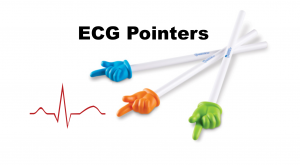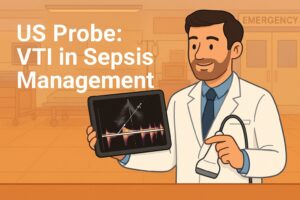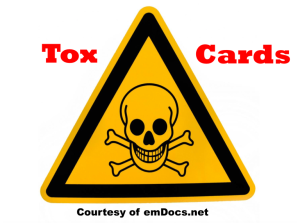Author: Anatoliy Goltser, MD (APD/Attending Physician, St Joseph’s Medical Center Stockton) // Reviewed by: Jessica Pelletier, DO, MHPE (APD/Assistant Professor of EM/Attending Physician, University of Missouri-Columbia); Alex Koyfman, MD (@EMHighAK); Brit Long, MD (@long_brit)
Introduction
With the recent severe nationwide shortage of intravenous (IV) fluids due to Hurricane Helene, we feel it is timely to provide a summary of the evidence regarding common uses of IV fluids for patients presenting to the emergency department (ED).
Volume status
Assessing volume status, especially in critically ill patients, can be challenging. Much of our understanding of the clinical signs of hypovolemia comes from studies performed on phlebotomy volunteers1,2 while our understanding of fluid overload comes from heart failure patients.2
There is substantial evidence for a few findings regarding volume status assessment. For acute large-volume loss in otherwise healthy patients (>1 L of blood volume), there is good evidence that orthostasis is sensitive and specific, which may be present in patients who have relatively normal vitals while supine.1,2 For hypervolemia in heart failure patients, orthopnea >2 pillows is the most reliable clinical finding,3,4 though an increase in peripheral edema and increased weight can be useful as well.2
Unfortunately, reliable volume status assessment features are helpful in a minority of clinical scenarios. For patients who are elderly, orthostasis is an unreliable clinical finding and may be present in the absence of dehydration.5 Clinical signs such as capillary refill, skin turgor, and axillary dryness are also fraught with poor inter-rater agreement.6-8 In patients who are on long-term hemodialysis, typical non-invasive signs of volume assessment seem to be unreliable as well.9
In terms of assessing volume status in general, Joseph et al. 202310 found that clinicians were 56% accurate in their assessments of patients admitted for heart failure when compared to the gold standard of blood volume measurement – a nuclear study utilizing radiolabeled red blood cells and albumin.11 A study by Stephan et al. 200112 found similar results among a cohort of critically ill patients.
Sepsis
There has been much controversy over the last two decades around the various nuances of volume resuscitation in ED patients with suspected sepsis, much of which goes beyond the scope of this limited review. The latest Society of Critical Care Medicine (SCCM) sepsis guidelines from 2021 recommend giving patients with signs of hypoperfusion an initial 30 ml/kg bolus as a best practice statement13 based on the PROCESS,14 ARISE,15 and PROMISE16 trials. Patients were enrolled in these trials if they had signs of shock, with mortality ranging from 18-29%. One of the hallmarks of sepsis care, based on the Rivers 200117 trial and still recommended by the latest SCCM guidelines is early detection of sepsis and initiation of early resuscitation.13 While there is good data that early antibiotics for patients in septic shock reduce mortality18-19 the role of early and aggressive volume resuscitation and its impacts on patient-centered outcomes remain unclear.
Over the past few years, mounting evidence has suggested that a restrictive approach may be non-inferior and possibly superior to the traditional 30 ml/kg approach, depending on the population being studied. Since the 2010s multiple trials have explored the feasibility of fluid restrictive resuscitation both on initial resuscitation in the ED, as well as in the intensive care unit (ICU). Since then, at least three separate meta-analyses20-22 have found that on the whole, a restrictive fluid administration approach (variously defined) is at least as effective and possibly better than a liberal approach.
The CLOVERS23 and CLASSICS24 trials suggest that a restrictive approach in ICU patients with septic shock after an initial fluid bolus in the ED is at least as effective and may hold benefits for some patients. In terms of the initial 30 ml/kg bolus in the ED, large trials are lacking but multiple small feasibility trials25-27 have shown a trend toward improved outcomes in the fluid-restrictive groups. A notable limitation is that the amount of fluids administered in fluid-restrictive groups have varied widely, from 500 ml to almost 50 ml/kg in the first 72 hours.
In lower-resource settings, the evidence is stronger against a liberal approach to volume resuscitation. Andrews et al. in 201728 showed increased mortality in sepsis patients in Zambia who received early and aggressive IV hydration compared with those in the standard therapy group. Similar to Andrews et al., the FEAST trial29 from 2011 conducted in Uganda, Kenya, and Tanzania, also showed significantly increased harms in the aggressive volume resuscitation group in children with sepsis and signs of shock.
For children in well-resourced settings, the data is less clear. Inwald et al. 201830 attempted to study this in the United Kingdom (UK) and Ireland; in a feasibility trial, they were able to enroll only 75 patients in 9 months across 13 medical centers. However, there were no major clinical outcome differences in the 10 ml/kg vs 20 ml/kg bolus groups partly due to a lower than expected incidence of adverse outcomes in this cohort. The latest SCCM pediatric sepsis guidelines31 recommend against a fluid bolus in children who are not hypotensive and who do not have access to intensive care, with a weak recommendation to give a 10-20 ml/kg initial bolus and up to a 40-60 ml/kg bolus in children with hypotension who do have access to critical care resources.
While a full pathophysiologic review of the benefits vs harms of bolusing IV fluids is beyond the scope of this review, Marik et al. 201932 give a detailed review of this and make a compelling argument that the previous one-size-fits-all resuscitation strategy should be abandoned and clinicians should use a holistic approach to guide volume resuscitation based on individual patient presentations.
As of now, there are no clear guidelines to reliably determine which patients would benefit from IV fluids and how much. Over the last few years, however, ultrasound has been increasingly playing an important role in the conversation with multiple studies looking at using ultrasound to predict fluid responsiveness in septic patients – for example, using the velocity time integral with passive leg raise. (For links to FOAM-ED ultrasound content, see the section after take-home points.) According to a meta-analysis by Chen et al. 2024,33 use of ultrasound may lead to a reduction in mortality, less volume of fluids given, and decreased hospital stay. Tullo et al. 202334 performed a literature review describing the various uses of ultrasound in guiding volume resuscitation that shows promise, especially in identifying those patients who would benefit most from either receiving fluids or having a more fluid restrictive approach. However, at this time, it is still too early to make broad-based recommendations regarding the widespread use of ultrasound to guide volume responsiveness evaluation in clinical care.
Oral rehydration for gastroenteritis
Oral rehydration is considered the standard of care for infants and children with acute mild-moderate dehydration,35 with good data to support this practice in a variety of settings.36-37 There is little evidence regarding oral rehydration in adults with gastroenteritis, though it seems reasonable that adults with mild dehydration could be safely hydrated orally.38
Assessing the severity of dehydration relies on clinical signs detailed in the section above. Several dehydration scales exist, the major ones being the World Health Organization (WHO) scale, the Gorelick scale, and the Clinical Dehydration Scale (CDS).39-40 These have been primarily studied for use in triage purposes where they seem to have some utility, though a meta-analysis by Falszewska41 concluded that their general use is limited. For a more detailed discussion on the limitations of clinical volume assessment, including the lack of an agreed-upon gold standard, see the section on volume status above. In practice, these scales are widely used and are recommended as a reference (e.g. ACEP, Life in the Fast Lane).
Table 1. WHO scale for dehydration in children. < 2 signs from columns B/C = no signs of dehydration; ≥ 2 signs in column B = moderate dehydration; ≥ 2 signs in column C = severe dehydration. Modified from: Pringle, K., Shah, S.P., Umulisa, I. et al. Comparing the accuracy of the three popular clinical dehydration scales in children with diarrhea. Int J Emerg Med 4, 58 (2011). https://doi.org/10.1186/1865-1380-4-58

During the 2017 IV fluid shortage, Patino et al. proposed a protocol for oral rehydration for pediatric and adult patients with mild dehydration, recommending two large sips, or about 30 ml, every 3-5 minutes for a total of 1 L over the course of about 2 hours. For patients with moderate dehydration, there is evidence to support rehydration using a nasogastric (NG) tube has similar outcomes when compared with IV fluids,42 with protocols available online (for example, this one from Ireland).
For patients with severe dehydration, the evidence regarding rehydration methods is lacking. The available recommendations35 recommend a 20 ml/kg fluid bolus for these patients. It’s important to note that patients with dehydration from gastroenteritis were excluded from the 2011 FEAST study.29 It is also important to note that it is generally agreed upon that patients with hyponatremic (sodium < 132 mEq/L) and hypernatremic (sodium > 150 mEq/L) dehydration probably require IV rehydration.35
Headache syndromes
It is common practice to give IV fluids to palliate headache symptoms in the ED. The justification for this has been that dehydration may precipitate a headache. In 2013 Richer et al.43 found that IV fluids did not improve symptoms in headache patients in a single pediatric ED. In 2019 and 2020 two small single-center randomized prospective studies both showed that IV fluids provide no additional benefit to standard headache management.44-45
These studies do have some limitations including small sample sizes – 49 and 60 patients respectively. The I-FiBH trial45 excluded patients who were deemed to have “severe dehydration”. Thirty percent of the patients in the I-FiBH trial had “vomited” prior to enrollment but there is no mention of the percentage of patients thought to have moderate dehydration. Pregnant patients were excluded in both trials.
It is reasonable to conclude from the available evidence that routine IV fluids are not necessary for most patients presenting to the ED with headaches. It may be reasonable to consider IV fluid administration in patients with moderate dehydration or prolonged vomiting.
Renal colic
The rationale supporting IV fluids is that they may facilitate stone passage and optimize renal perfusion, especially in patients who have been vomiting or have some degree of dehydration. The rationale against IV fluids is that they may worsen pain by increasing the ureteral pressure, leading to worsening obstructive symptoms and perhaps exacerbating any kidney injury sustained from the obstruction.
Data on the benefits of IV fluids for renal colic patients has been limited to two small studies and a Cochrane meta-analysis from 201246 examining those two studies. The first study was by Edna et al.47 from 1983 looking at 60 participants who either received IV fluids over 6 hours or received no fluids. There was no difference in pain or necessity for urologic intervention between the two groups. The second study by Springhart et al.48 in 2006 enrolled 58 patients divided into two groups. One group received a 2 L normal saline (NS) bolus over 2 hours, and the second group received 20 ml/hr of NS. There was no difference in pain or stone passage rates between groups.
Tarplin et al. 2015,49 performed a retrospective review of 5,000 patients across the Cleveland Clinic health system looking at the prevalence of IV fluid used for renal colic and found that about 80% of patients were given fluid boluses despite the absence of signs of dehydration. The Patino et al.38 oral rehydration protocol did not include patients with known or suspected renal colic, but depending on resource availability, this may be an area where we may have opportunities to conserve resources without patient harm.
IV antibiotics before discharge
For most patients, IV antibiotics confer no advantage over oral antibiotics.50-53 IV antibiotics are indicated for patients who are unable to tolerate oral intake (e.g. due to gut hypoperfusion or ileus), shock, suspected bacteremia, deep-seated infections like osteomyelitis, and those at risk for failure of outpatient treatment.
One controversy that remains is whether or not an initial dose of IV antibiotics in the ED may prevent repeat ED visits and possibly failure of outpatient treatment.54 This was examined retrospectively by Poh et al. looking at patients diagnosed with urinary tract infection (UTI) at three separate medical centers in Taiwan. The patients who received a dose of IV antibiotics (20%) were more likely to be older with more comorbidities and have vital sign alterations such as fever and/or tachycardia. After performing a logistic regression controlling for age and comorbidities they found that in this population, an initial dose of IV antibiotics was associated with a slightly lower chance of a repeat visit to the ED at 72 hours. Another retrospective study by Chung et al. 202355 looked at 429 patients over age 65 with a UTI and found that patients who received IV antibiotics were more likely to return to the ED at 72 hours. Choudhari et al. 201856 retrospectively analyzed visits from 30,000 children from 36 hospitals across the US and found that patients who received IV antibiotics were just as likely to return at 72 hours as those who did not. In summary, it is unclear whether receiving antibiotics in the ED prior to discharge actually changes patient-centered outcomes. If patients can tolerate oral antibiotics, they typically constitute adequate therapy.
Wound irrigation
A recent ACEP resolution encouraged emergency medicine practitioners to use tap water for routine wound irrigation.57 This practice is supported by a recent Cochrane review58 as well as a literature review by Holman59 describing multiple head-to-head studies showing no difference in infection or contamination rates. The caveat is that this data only applies to settings where tap water is potable.
For chemical exposure of the eye requiring immediate and copious irrigation, tap water is often preferred due to its availability and cost, as well as an absence of substantial benefit for buffered solutions.60
Clinicians often recommend sinus irrigation for patients with upper respiratory infections or sinus infections with associated nasal congestion. Only sterile water is recommended for this indication in light of case reports of invasive amebic infections.61
Saline vs. balanced solution
The debate around this topic has recently been re-ignited with the publication of SALT-ED,62 SMART,63 and BASICS64 trials. For a more detailed discussion on the topic, check out this emDOCs article by Leonard et al. 2021.65
Since then there have been several meta-analyses66-68 looking at the effects of saline vs balanced solution in critically ill adults. Chen et al. and Wang et al. both found increased rates of acute kidney injury (AKI) in the saline cohort, similar to the SMART and SALT-ED trials. Dong et al. found no difference in AKI between the two cohorts but found decreased mortality in the saline group among traumatic brain injury (TBI) patients, similar to the BASICS study.
For diabetic ketoacidosis (DKA) patients, a subgroup analysis of the SMART and SALT-ED trials69 showed a slightly more rapid resolution of symptoms in the balanced solution group – a median 3-hour difference for DKA resolution, and a median 4-hour difference for insulin infusion. A recent meta-analysis of 11 trials on the topic70 found no significant difference in time to resolution of symptoms, incidence of AKI, or hypokalemia.
For the treatment of severe dehydration in kids, a recent Cochrane review71 found that patients treated with a balanced solution required less time in the hospital by a mean of 0.35 days compared to those treated with normal saline. The balanced solution group also had higher serum pH and sodium bicarbonate, and less incidence of hypokalemia.
Take-Home Points:
- Clinical volume assessment may be unreliable, especially for patients who are elderly or have comorbidities resulting in disruption of volume regulatory mechanisms such as congestive heart failure and end-stage renal disease. For patients without frank signs of shock, it is reasonable to trial oral hydration prior to moving on to IV fluids.
- While some patients with septic shock may benefit from a more restrictive fluid resuscitation than the current 30 ml/kg recommends, there is insufficient evidence to support this practice routinely; and as of this writing, there is not an established way to reliably identify these patients. A volume-restrictive resuscitation strategy for patients admitted with sepsis to the ICU is equally effective compared to a traditional liberal approach.
- Routine use of IV fluids for headache syndromes and renal colic is probably of no benefit.
- Routine use of IV antibiotics prior to discharge is of little benefit for pediatric patients and probably for adults as well. There may be a role for IV antibiotics for some elderly patients at high risk of bacteremia or treatment failure in certain health systems that have robust outpatient resources, but its routine use is otherwise of little benefit and should be abandoned.
- Tap water irrigation for most wounds and eyes is as safe and effective as saline.
- Balanced solutions may improve outcomes in critically ill adults, patients with baseline kidney disease and hyperchloremia, DKA, and children with severe dehydration. In critically ill patients with TBI, saline may be the fluid of choice.
Further #FOAMed:
- POCUS for Assessing Volume Responsiveness – Core Ultrasound
- Volume Assessment Using POCUS in the Emergency Department
References
- McGee S, Abernathy WB 3rd, Simel DL. The rational clinical examination. Is this patient hypovolemic? JAMA. 1999 Mar 17;281(11)
- Raco J, Peterson B, Muallem S. Assessment of Volume Status in Hospitalized Patients With Chronic Heart Failure. Cardiol Res. 2023 Feb 25;14(1):2–11
- Wang CS, FitzGerald MJ, et al. Does this dyspneic patient in the emergency department have congestive heart failure? JAMA. 2005 Oct 19;294(15):1944-56.
- Drazner MH, Hellkamp AS, et al. Value of clinician assessment of hemodynamics in advanced heart failure: the ESCAPE trial. Circ Heart Fail. 2008 Sep;1(3):170-7.
- Koziol-McLain J, Lowenstein SR, Fuller B. Orthostatic vital signs in emergency department patients. Ann Emerg Med. 1991 Jun;20(6):606-10.
- Fayomi O, Maconochie I, Body R. Is skin turgor reliable as a means of assessing hydration status in children? Emerg Med J. 2007 Feb;24(2):124–125.
- Gross CR, Lindquist RD. Clinical indicators of dehydration severity in elderly patients. J Emerg Med. 1992 May-Jun;10(3):267-74.
- Elhassan MG, Chao PW, Curiel A. The Conundrum of Volume Status Assessment: Revisiting Current and Future Tools Available for Physicians at the Bedside. Cureus. 2021 May 26;13(5):e15253.
- Ishibe S, Peixot AJ. Methods of assessment of volume status and intercompartmental fluid shifts in hemodialysis patients: implications in clinical practice. Semin Dial. 2004 Jan-Feb;17(1):37-43.
- Joseph J, Nguyen W, et al. Abstract 18863: Clinical Assessment of Volume Status in Heart Failure is Inaccurate at Detecting Hypervolemia and Anemia as Quantified by Blood Volume Measurement. Circulation. 2023 Volume 148, Number Suppl 1
- Margouleff D. Blood volume determination, a nuclear medicine test in evolution. Clin Nucl Med. 2013 Jul;38(7):534-7.
- Stephan F, Flahault A, Dieudonne N, et al. Clinical evaluation of circulating blood volume in critically ill patients–contribution of a clinical scoring system. Br J Anaesth. 2001 Jun;86(6):754-62
- Evans L et al. Surviving sepsis campaign: international guidelines for management of sepsis and septic shock 2021. Intensive Care Med. 2021 Nov;47(11):1181-1247
- The ProCESS Investigators. A Randomized Trial of Protocol-Based Care for Early Septic Shock. N Engl J Med. 2014;370:1683-1693
- The ARISE Investigators and the ANZICS Clinical Trials Group. Goal-Directed Resuscitation for Patients with Early Septic Shock. N Engl J Med. 2014;371:1496-1506
- Mouncey PR, Osborn TM, et al. Trial of Early, Goal-Directed Resuscitation for Septic Shock. N Engl J Med 2015;372:1301-1311
- Rivers et al Early Goal-Directed Therapy in the Treatment of Severe Sepsis and Septic Shock. N Engl J Med. 2001;345:1368-1377
- Im, Y., Kang, D., Ko, RE. et al. Time-to-antibiotics and clinical outcomes in patients with sepsis and septic shock: a prospective nationwide multicenter cohort study. Crit Care 26, 19 (2022)
- Liu VX, Fielding-Singh V, et al. The Timing of Early Antibiotics and Hospital Mortality in Sepsis. Am J Respir Crit Care Med. 2017 Oct 1;196(7):856–863.
- Abdelbaky AM, Elmasry WG, Awad AH. Restrictive Versus Liberal Fluid Regimen in Refractory Sepsis and Septic Shock: A Systematic Review and Meta-Analysis. Cureus. 2023 Oct 27;15(10)
- Reynolds PM, Stefanos S, MacLaren R. Restrictive resuscitation in patients with sepsis and mortality: A systematic review and meta-analysis with trial sequential analysis. Pharmacotherapy. 2023 Feb;43(2):104-114.
- Sivapalan P, Ellekjaer KL, Jessen MK, et al. Lower vs Higher Fluid Volumes in Adult Patients With Sepsis: An Updated Systematic Review With Meta-Analysis and Trial Sequential Analysis. Chest. 2023. Volume 164, Issue 4, Pages 892-912
- The National Heart, Lung, and Blood Institute Prevention and Early Treatment of Acute Lung Injury Clinical Trials Network. Early Restrictive or Liberal Fluid Management for Sepsis-Induced Hypotension. N Engl J Med. 2023;388:499-510
- Meyhoff TS, Hjortrup PB, Wetterslev J, et al. Restriction of Intravenous Fluid in ICU Patients with Septic Shock. N Engl J Med. 2022;386:2459-2470
- Jessen MK, Anderson LW, Thomsen MLH, et al. Restrictive fluids versus standard care in adults with sepsis in the emergency department (REFACED): A multicenter, randomized feasibility trial. Acad Emerg Med. 2022 Aug 5;29(10)
- Corl KA, Prodromou M, Merchant, RC, et al. The Restrictive IV Fluid Trial in Severe Sepsis and Septic Shock (RIFTS): A Randomized Pilot Study. Critical Care Medicine. 2019. 47(7):p 951-959
- Macdonald, S.P.J., Keijzers, G., Taylor, D.M. et al. Restricted fluid resuscitation in suspected sepsis associated hypotension (REFRESH): a pilot randomised controlled trial. Intensive Care Med. 2018 44, 2070–2078 (2018)
- Andrews B, Semler MW, Muchemwa L, et al. Effect of an Early Resuscitation Protocol on In-hospital Mortality Among Adults With Sepsis and Hypotension: A Randomized Clinical Trial. JAMA 2017 Oct 3;318(13):1233-1240.
- Maitland K, Kiguli S, Opoka RO, et al Mortality after Fluid Bolus in African Children with Severe Infection. N Engl J Med. 2011;364:2483-2495
- Inwald DP, Canter R, Woolfall K, et al. Restricted fluid bolus volume in early septic shock: results of the Fluids in Shock pilot trial. Arch Dis Child. 2018 Aug 7;104(5):426–431
- Scott W, Peters MJ, Alhazzani W, et al. Surviving Sepsis Campaign International Guidelines for the Management of Septic Shock and Sepsis-Associated Organ Dysfunction in Children Pediatric Critical Care Medicine. 2020 21(2):p e52-e106
- Marik PE, Byrne L, van Haren F. Fluid resuscitation in sepsis: the great 30 mL per kg hoax. J Thorac Dis. 2020;12(Suppl 1):S37-S47.
- Zheyuan C, Xiao H, Ying L, et al. Ultrasound-guided fluid resuscitation versus usual care guided fluid resuscitation in patients with septic shock: a systematic review and meta-analysis. Emergency and Critical Care Medicine. 2024. 4(2):p 82-89.
- Tullo G, Candelli M, Gasparrini I, et al. Ultrasound in Sepsis and Septic Shock—From Diagnosis to Treatment. J Clin Med. 2023 Feb 2;12(3):1185.
- Powers KS. Dehydration: Isonatremic, Hyponatremic, and Hypernatremic Recognition and Management. Pediatr Rev July 2015; 36 (7): 274–285.
- Bellemare S, Hartling L, Wiebe N, Russell K, Craig WR, McConnell D, Klassen TP. Oral rehydration versus intravenous therapy for treating dehydration due to gastroenteritis in children: a meta-analysis of randomised controlled trials. BMC Med. 2004 Apr 15;2:11
- Fonseca BK, Holdgate A, Craig JC. Enteral vs Intravenous Rehydration Therapy for Children With Gastroenteritis: A Meta-analysis of Randomized Controlled Trials. Arch Pediatr Adolesc Med. 2004;158(5):483–490. doi:10.1001/archpedi.158.5.483
- Patino AM, Marsh RH, Nilles EJ, et al. Facing the Shortage of IV Fluids — A Hospital-Based Oral Rehydration Strategy. N Engl J Med 2018;378:1475-1477
- Pringle K, Shah SP, Umulisa I, et al. Comparing the accuracy of the three popular clinical dehydration scales in children with diarrhea. Int J Emerg Med. 2011 Sep 9;4:58.
- Bailey B, Gravel J, Goldman RD, Friedman JN, Parkin PC. External validation of the clinical dehydration scale for children with acute gastroenteritis. Acad Emerg Med. 2010 Jun;17(6):583-8.
- Falszewska A, Szajewska H, Dziechciarz P. Diagnostic accuracy of three clinical dehydration scales: a systematic review. Arch Dis Child. 2018 Apr;103(4):383-388.
- Nager AL, Wang VJ. Comparison of nasogastric and intravenous methods of rehydration in pediatric patients with acute dehydration. Pediatrics. 2002 Apr;109(4):566-72.
- Richer, L., Craig, W. and Rowe, B. Randomized Controlled Trial of Treatment Expectation and Intravenous Fluid in Pediatric Migraine. Headache: The Journal of Head and Face Pain. 2014. 54: 1496-1505
- Jones CW, Remboski LB, Freeze B, Braz VA, Gaughan JP, McLean SA. Intravenous Fluid for the Treatment of Emergency Department Patients With Migraine Headache: A Randomized Controlled Trial. Ann Emerg Med. 2019 Feb;73(2):150-156.
- Zitek T, Sigal T, Sun G, Martin Manuel C, Tran K. I-FiBH trial: intravenous fluids in benign headaches-a randomised, single-blinded clinical trial. Emerg Med J. 2020 Aug;37(8):469-473.
- Worster AS, Bhanich Supapol W. Fluids and diuretics for acute ureteric colic. Cochrane Database Syst Rev. 2012 Feb 15;2012(2):CD004926.
- Edna TH, Hesselberg F. Acute ureteral colic and fluid intake. Scand J Urol Nephrol. 1983;17(2):175-8.
- Springhart WP, Marguet CG, Sur RL, Norris RD, Delvecchio FC, Young MD, Sprague P, Gerardo CA, Albala DM, Preminger GM. Forced versus minimal intravenous hydration in the management of acute renal colic: a randomized trial. J Endourol. 2006 Oct;20(10):713-6.
- Tarplin S, Larson B, Byrne M, Loftus C, Monga M. Fluid Bolus for Renal Colic: Current Practice. Urol Pract. 2015 Sep;2(5):239-243.
- Helman A “IV vs. PO: Which Antibiotics Are Better for Common ED Infections?” ACEP Now, https://www.acepnow.com/article/iv-vs-po-which-antibiotics-are-better-for-common-ed-infections/. Accessed 25 Nov. 2024.
- Swaminathan A. “Clinical Conundrums: Should You Give the First Dose of Antibiotics IV Before Discharging Home on Oral Antibiotics?”, REBEL EM blog, January 9, 2024. Available at: https://rebelem.com/clinical-conundrums-should-you-give-the-first-dose-of-antibiotics-iv-before-discharging-home-on-oral-antibiotics/.
- McCarthy K, Avent M. Oral or intravenous antibiotics? Aust Prescr. 2020 Apr;43(2):45-48.
- Kaal AG, Roos R, de Jong P, Pepping RMC, van den Berg JMW, van Aken MO, Steyerberg EW, Numans ME, van Nieuwkoop C. Oral versus intravenous antibiotic treatment of moderate-to-severe community-acquired pneumonia: a propensity score matched study. Sci Rep. 2024 Apr 9;14(1):8271.
- Poh XE, Wu KH, Chen CC, Huang JB, Cheng FJ, Chiu IM. Outcomes for Patients with Urinary Tract Infection After an Initial Intravenous Antibiotics Dose Before Emergency Department Discharge. Infect Dis Ther. 2021 Sep;10(3):1479-1489. doi: 10.1007/s40121-021-00469-9. Epub 2021 Jun 14.
- Chung HS, Bae SJ, Namgung M, Choi YH, Choi JY, Lee DH. Effects of an Initial Single Dose of Intravenous Antibiotics on Emergency Department Revisits Among Elderly Patients with Urinary Tract Infections. Urol J. 2023 Feb 27;20(2):135-140.
- Chaudhari PP, Monuteaux MC, Bachur RG. Emergency Department Revisits After an Initial Parenteral Antibiotic Dose for UTI. Pediatrics. 2018 Sep;142(3):e20180900.
- Timely ACEP Council resolution encourages using tap water for wound irrigation. ACEP. Accessed November 20, 2024. https://acep.org/news/acep-newsroom-articles/timely-council-resolution-encourages-using-tap-water-for-wound-irrigation.
- Fernandez R, Green HL, Griffiths R, Atkinson RA, Ellwood LJ. Water for wound cleansing. Cochrane Database Syst Rev. 2022 Sep 14;9(9):CD003861.
- Holman M. Using tap water compared with normal saline for cleansing wounds in adults: a literature review of the evidence. J Wound Care. 2023 Aug 2;32(8):507-512.
- Claassen K, Rodil Dos Anjos D, Broding HC. Current status of emergency treatment of chemical eye burns in workplaces. Int J Ophthalmol. 2021 Feb 18;14(2):306-309.
- Yoder JS, Straif-Bourgeois S, Roy SL, et al. Primary amebic meningoencephalitis deaths associated with sinus irrigation using contaminated tap water. Clin Infect Dis. 2012 Nov;55(9):e79-85.
- Self WH, Semler MW, Wanderer JP, et al; SALT-ED Investigators. Balanced Crystalloids versus Saline in Noncritically Ill Adults. N Engl J Med. 2018 Mar 1;378(9):819-828.
- Semler MW, Self WH, Wanderer JP, et al; SMART Investigators and the Pragmatic Critical Care Research Group. Balanced Crystalloids versus Saline in Critically Ill Adults. N Engl J Med. 2018 Mar 1;378(9):829-839.
- Zampieri FG, Machado FR, Biondi RS, et al. Effect of Intravenous Fluid Treatment With a Balanced Solution vs 0.9% Saline Solution on Mortality in Critically Ill Patients: The BaSICS Randomized Clinical Trial. JAMA. 2021;326(9):818–829.
- Leonard G et al. Lactated ringers versus normal saline: myths and pearls in the ED. emDOCs.net – Emergency Medicine Education. August 30, 2021. Accessed November 25, 2024. https://www.emdocs.net/lactated-ringers-versus-normal-saline-myths-and-pearls-in-the-ed/
- Dong, WH., Yan, WQ., Song, X. et al. Fluid resuscitation with balanced crystalloids versus normal saline in critically ill patients: a systematic review and meta-analysis. Scand J Trauma Resusc Emerg Med. 2022. 30, 28
- Wang, P., Huang, Y., Li, J. et al. Balanced crystalloid solutions versus normal saline in intensive care units: a systematic review and meta-analysis. Int Urol Nephrol 2023. 55, 2829–2844
- Chen Y, Gao Y. Comparison of Balanced Crystalloids versus Normal Saline in Critically Ill Patients: A Systematic Review with Meta-Analysis and Trial Sequential Analysis of Randomized Controlled Trials. Ther Clin Risk Manag. 2023 Oct 11;19:783-799.
- Self WH, Evans CS, Jenkins CA, et al. Clinical Effects of Balanced Crystalloids vs Saline in Adults With Diabetic Ketoacidosis: A Subgroup Analysis of Cluster Randomized Clinical Trials. JAMA Netw Open. 2020;3(11):e2024596.
- Liu Y, Zhang J, Xu X, Zou X. Comparison of balanced crystalloids versus normal saline in patients with diabetic ketoacidosis: a meta-analysis of randomized controlled trials. Front Endocrinol (Lausanne). 2024 May 21;15:1367916.
- Florez ID, Sierra J, Pérez-Gaxiola G. Balanced crystalloid solutions versus 0.9% saline for treating acute diarrhoea and severe dehydration in children. Cochrane Database Syst Rev. 2023 May 17;5(5):CD013640.








